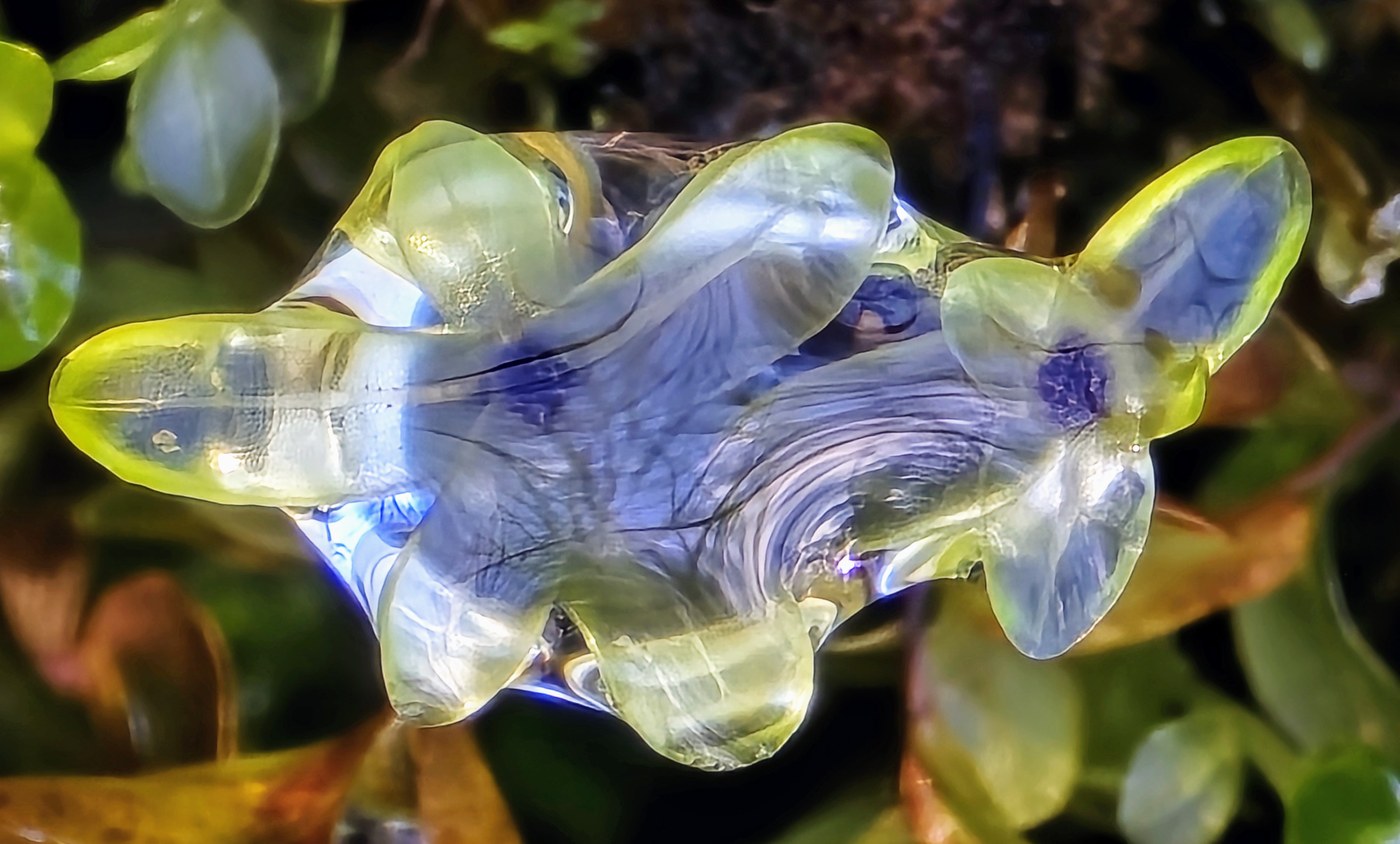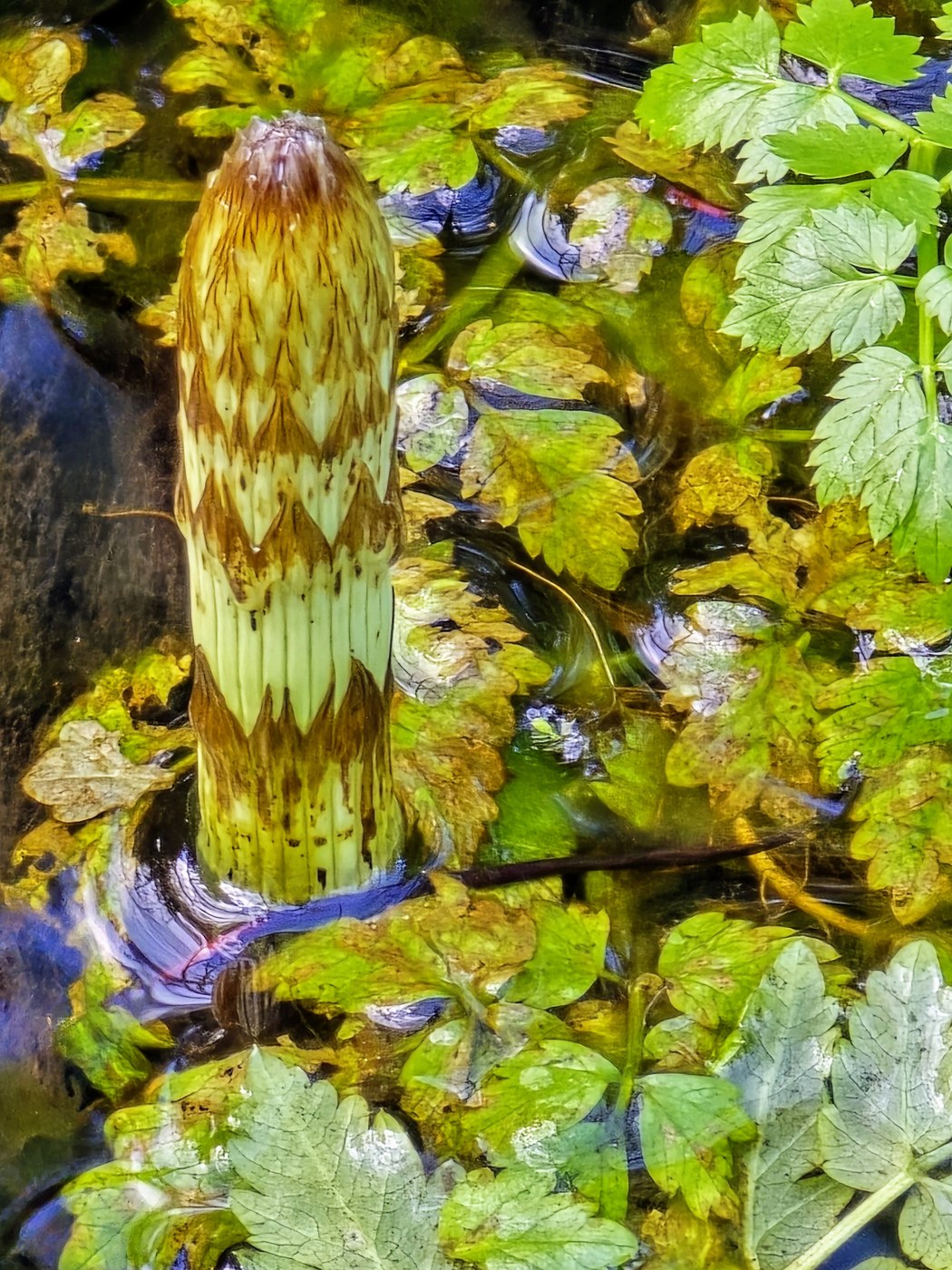There is no snow on Tradition plateau and only a few puddles and spots of mud. On this sunny day on Tiger Mt I saw the first non-tiny insects of the spring, a single hoverfly (photo 1, link to wiki below) and something in the fly family (a gnat or midge was google's guess, photo 2). As always there was a world of visual delights (photo 3 and more photos in the attached slideshow). The colder than average temperatures have slowed down some plant progression; I can for sure see that virtually no new salmon berries have been blooming.
Photo 4 is one of the fertile horsetail stems emerging on the swamp trail amongst the water-parsley. From wikipedia (link below) - (Horsetail) has separate green photosynthetic sterile stems, and pale yellowish non-photosynthetic spore-bearing fertile stems. The sterile stems, produced in late spring and dying down in late autumn, are 30–150 cm (rarely to 240 cm) tall (the tallest species of horsetail outside of tropical regions) and 1 cm diameter, heavily branched, with whorls of 14–40 branches, these up to 20 cm long, 1–2 mm diameter and unbranched, emerging from the axils of a ring of bracts. The fertile stems are produced in early spring before the sterile shoots, growing to 15–45 cm tall with an apical spore-bearing strobilus 4–10 cm long and 1–2 cm broad, and no side branches; the spores disperse in mid spring, with the fertile stems dying immediately after spore release. It also spreads by means of rhizomes that have been observed to penetrate 4 meters into wet clay soil, spreading laterally in multiple layers. Occasional plants produce stems that are both fertile and photosynthetic.
2024 spring milestones on Tiger Mt:
3-5 (sunny in the 40's) first hoverfly, first significantly sized fly family (midge or gnat)
Photo 4 is one of the fertile horsetail stems emerging on the swamp trail amongst the water-parsley. From wikipedia (link below) - (Horsetail) has separate green photosynthetic sterile stems, and pale yellowish non-photosynthetic spore-bearing fertile stems. The sterile stems, produced in late spring and dying down in late autumn, are 30–150 cm (rarely to 240 cm) tall (the tallest species of horsetail outside of tropical regions) and 1 cm diameter, heavily branched, with whorls of 14–40 branches, these up to 20 cm long, 1–2 mm diameter and unbranched, emerging from the axils of a ring of bracts. The fertile stems are produced in early spring before the sterile shoots, growing to 15–45 cm tall with an apical spore-bearing strobilus 4–10 cm long and 1–2 cm broad, and no side branches; the spores disperse in mid spring, with the fertile stems dying immediately after spore release. It also spreads by means of rhizomes that have been observed to penetrate 4 meters into wet clay soil, spreading laterally in multiple layers. Occasional plants produce stems that are both fertile and photosynthetic.
2024 spring milestones on Tiger Mt:
3-5 (sunny in the 40's) first hoverfly, first significantly sized fly family (midge or gnat)
3-2 first shoots, great or northern giant horsetail, swamp trail, water-covered portion (Equisetum telmateia)
3-2 flower buds, mouse-ear cress or thalecress, gas line trail (Arabidopsis thaliana)
3-1 flower buds, currant (probably red flowering) just above East Sunset Way trailhead
2-27 red huckleberry in bloom, multiple trails, (Vaccinium parvifolium) parvifolium means small-leafed
2-27 Pacific waterleaf shoots (Park Pointe)
2-27 sitka willow flower buds (gas line trail, end of Big Tree trail)
2-25 cherry plum blooming (Tradition Lake loop)
2-24 first moths (small, tan-orange, same species that came out first last year)
2-24 colt's foot in bloom, poo poo point trail
2-22 salmonberry flowers (Swamp trail)
2-22 tall Oregon grape flowers open (Power Line above Sunset Way)
2-17 stinging nettle shoots
2-14 colt's foot flower buds (Poo Poo Point trail)
2-13 colt's foot (Petasites frigidus) shoots appear (section line, they must have been many days earlier on the Poo Poo point trail)
2-13 red elderberry leaves (Sambucas racemosa)
2-8 tall Oregon grape flower buds (Mahonia aquifolium)
2-2 oso-berry flower (Oemleria cerasiformis)
2-1 male Pacific Wrens singing for mates and territory







Comments
Skip32 on Swamp Trail, High School Trail, Puget Power
Thanks for the photo art and botanical information.
Posted by:
Skip32 on Mar 06, 2024 08:50 AM
AlpsDayTripper on Swamp Trail, High School Trail, Puget Power
You're welcome, my pleasure and delight!
Posted by:
AlpsDayTripper on Mar 06, 2024 08:55 AM
BlueGoat on Swamp Trail, High School Trail, Puget Power
Stunning hoverfly photo!
Posted by:
BlueGoat on Mar 06, 2024 02:51 PM
AlpsDayTripper on Swamp Trail, High School Trail, Puget Power
Thanks!
Posted by:
AlpsDayTripper on Mar 06, 2024 10:08 PM
Explore104 on Swamp Trail, High School Trail, Puget Power
Do you mind sharing what camera you used?
Beautiful photos and information!
Posted by:
Explore104 on Mar 06, 2024 09:17 PM
AlpsDayTripper on Swamp Trail, High School Trail, Puget Power
Thanks! A Samsung S24 Ultra, with a tripod for a few of them including the hoverfly.
Posted by:
AlpsDayTripper on Mar 06, 2024 10:07 PM
Alpine Wanderer on Swamp Trail, High School Trail, Puget Power
Nice photos! Your forth photo looks like a Monet painting! :) All creatures great and small...
Posted by:
Alpine Wanderer on Mar 13, 2024 11:14 AM
AlpsDayTripper on Swamp Trail, High School Trail, Puget Power
Wow, thanks for the nice compliment!
Posted by:
AlpsDayTripper on Mar 13, 2024 11:19 AM